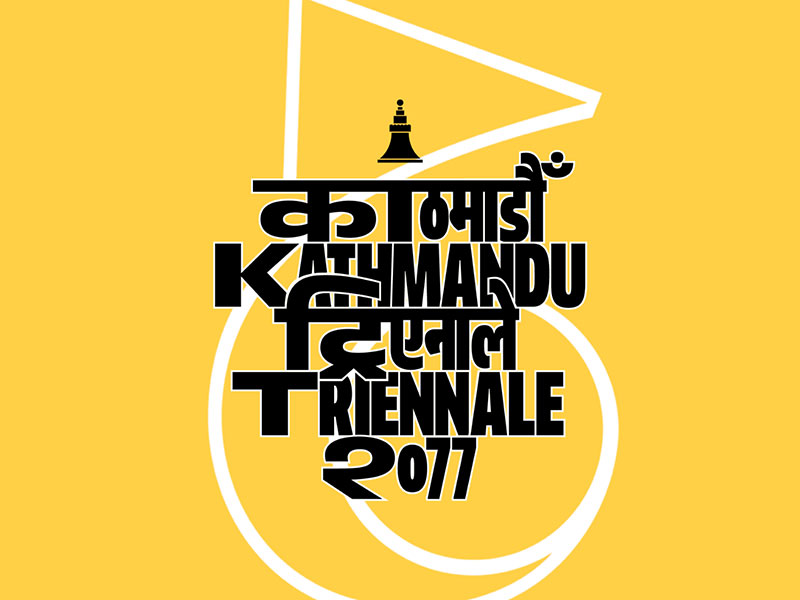 KT2077
KT2077 Deferred edition of international art project Kathmandu Triennale 2077 to take place in 2022
Kathmandu/IBNS: Kathmandu Triennale, Nepal’s premier international exhibition of contemporary art has announced the dates of its fourth edition to be held in 2022.
It was earlier scheduled for 2020 but had to be cancelled because of the COVID-19 pandemic.
Organized by Nepal’s Ministry of Culture, Tourism and Civil Aviation and Siddhartha Arts Foundation, the ‘Kathmandu Triennale 2077’ will take place between February 11 and March 11 March.
The curatorial team is led by Artistic Director Cosmin Costinas and co-curators Sheelasha Rajbhandari and Hit Man Gurung.
The organizers have decided to retain the title Triennale 2077 for the upcoming edition, which actually refers to Nepali calendar year Bikram Samvat 2077, which coincided with the year 2020, in deference to the promises of a renewed beginning after the dark phase of the pandemic.
According to the organizers, ‘the time of the Triennale has also become arbitrary and nonlinear; at once in the past and the future of 2077, and the present of 2022, mediating between systems of counting time, uneasy synchronicities, and struggles to escape and reclaim histories, often running afoul of each other.’
These multiplicities and displacements across time are reflected in the themes and works of artists of the Triennale.
The organizers said in a release that over 300 artworks from more than 100 artists and collaborators from 40 nations will be staged across five culturally and historically significant venues in three clusters; Patan, Kathmandu, and Boudha.
A UNESCO world heritage site and former royal residence of the Malla dynasty between 14th and 18th centuries, Patan Museum sits amidst Newa-style temples in a section of the Royal Palace at Durbar Square, a portion of which served as a prison until 1990; Bahadur Shah Baithak, built in 1790, was used by the subsequent Gorkha dynasty as a centre for military strategy, as well as to house the arsenal, behind its large doorway owing to the war elephants; initiated by leading Nepali modern artist Lain Singh Bandel, Nepal Art Council was founded in 1962 under the patronage of King Mahendra as one of the country’s largest art venues; designed in 1972 as a modernist fantasy, the Taragaon Museum was restored and opened in 2014 together with a unique archive reflecting the efforts to preserve Nepal’s cultural and architectural heritage, alongside the display of contemporary art; Siddhartha Art Gallery was established in 1987, as one of Nepal’s main art spaces presenting and supporting Nepali and international contemporary artists of different generations.
There will also be a series of curated public programmes, including performances, workshops, guided tours, seminars and more, parallel to the exhibition.
Led by the Director Sharareh Bajracharya and Founder/Chairperson Sangeeta Thapa, Kathmandu Triennale has been planned and produced by a team of art-workers from Nepal and abroad.
The team at Wkshps has created this edition’s visual language and the upcoming publication.
Kathmandu Triennale 2077 has announced a partial list of participating artists, collectives and groups, which is available here.
Kathmandu Triennale (KT), now in its fourth edition, previously branded as the Kathmandu International Art Festival, is Nepal’s premier international platform for global contemporary art.
Getting there:
Air connectivity between India and Nepal is operating under the bubble agreement signed between the two countries. Bus operations between the two countries (running between New Delhi and Kathmandu) have also been resumed. Both countries have signed memorandums of understanding to honour each other’s vaccine certificates.
Indian travelers to Nepal have to produce COVID-19 vaccination certificate showing full dose of vaccination with the last does taken at least 14 days prior to arriving in Nepal as well as COVID-19 test report (RT-PCR, Gene Expert, True NAAT or WHO accredited test) showing negative result done within last 72 hours of boarding from the first airport or, if the traveler is entering through land border, taken within 72 hours of entry.
Indians travelling to Nepal must be in possession of valid travel documents – a valid Indian passport or a valid voter ID issued by the Election Commission of India; no other document (including Aadhaar) is considered valid.
Support Our Journalism
We cannot do without you.. your contribution supports unbiased journalism
IBNS is not driven by any ism- not wokeism, not racism, not skewed secularism, not hyper right-wing or left liberal ideals, nor by any hardline religious beliefs or hyper nationalism. We want to serve you good old objective news, as they are. We do not judge or preach. We let people decide for themselves. We only try to present factual and well-sourced news.







